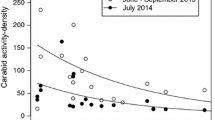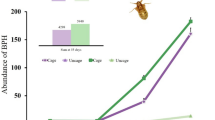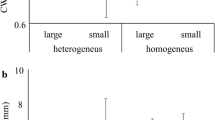Abstract
The natural enemies of herbivorous pests in cropping systems may relocate to adjacent habitats in response to declining habitat quality in heterogeneous landscapes. In this study, we measured the cross-edge spillover of ladybeetles from wheat fields to shelterbelts, and tested how landscape variables at various spatial scales influence ladybeetle populations. We conducted a large-scale sampling study of agricultural landscapes differing in structural complexity during 2012 and 2013. The effects of landscape variables (i.e., landscape diversity and the percentage of woody habitats) on the ladybeetle abundance were investigated. Propylea japonica (Thunberg) and Harmonia axyridis (Pallas) were the dominant ladybeetle species. The abundances of ladybeetles in spillover were positively correlated with the percentage of woody area, and negatively correlated with landscape diversity and edge density of crop habitats. It indicates that a low diversity landscape with a large area of shelterbelts supports larger ladybeetle abundance in spillover compared with a high diversity landscape with a limited area of shelterbelts. By contrast, greater numbers of within-field ladybeetles were associated with landscape diversity increase. Landscape features at the spatial scale of 2.5–3 km could best predict the abundance of ladybeetles in spillover, whereas the best prediction model for ladybeetle abundance within field was at the 1.5 km scale. These results suggest that the landscape variables influence ladybeetle abundance differently in spillover and within fields. The introduction of shelterbelts in the agricultural landscape could enhance the conservation of ladybeetle populations.

Similar content being viewed by others
References
Bianchi FJJA, van der Werf W (2003) The effect of the area and configuration of hibernation sites on the control of aphids by Coccinella septempunctata (Coleoptera: Coccinellidae) in agricultural landscapes: a simulation study. Environ Entomol 32:1290–1304
Bianchi FJJA, van der Werf W (2004) Model evaluation of the function of prey in non-crop habitats for biological control by ladybeetles in agricultural landscapes. Ecol Model 171:177–193
Bianchi FJJA, van Wingerden WKRE, Griffioen AJ, van der Veen M, van der Straten MJJ, Wegman RMA, Meeuwsen HAM (2005) Landscape factors affecting the control of Mamestra brassicae by natural enemies in Brussels sprout. Agric Ecosyst Environ 107:145–150
Bianchi FJJA, Booij CJH, Tscharntke T (2006) Sustainable pest regulation in agricultural landscapes: a review on landscape composition, biodiversity and natural pest control. Proc R Soc B 273:1715–1727
Bianchi FJJA, Honek A, van der Werf W (2007) Changes in agricultural land use can explain population decline in a ladybeetle species in the Czech Republic: evidence from a process-based spatially explicit model. Landsc Ecol 22:1541–1554
Bianchi FJJA, Goedhart PW, Baveco JM (2008) Enhanced pest control in cabbage crops near forest in The Netherlands. Landsc Ecol 23:595–602
Burnham KP, Anderson DR (2002) Model selection and multimodel inference, 2nd edn. Springer, New York
Chaplin-Kramer R, O’Rourke ME, Blitzer EJ, Kremen C (2011) A meta-analysis of crop pest and natural enemy response to landscape complexity. Ecol Lett 14:922–932
Core Team R (2013) R: a language and environment for statistical computing. R Foundation for Statistical Computing, Vienna
Dong ZK, Gao FJ, Zhang RZ (2012) Use of ryegrass strips to enhance biological control of aphids by ladybirds in wheat fields. Insect Sci 19:529–534
Elliott NC, Kieckhefer RW, Lee JH, French BW (1999) Influence of within-field and landscape factors on aphid predator populations in wheat. Landsc Ecol 14:239–252
Elliott NC, Kieckhefer RW, Beck DA (2002) Effect of aphids and the surrounding landscape on the abundance of Coccinellidae in cornfields. Biol Control 24:214–220
Gardiner MM, Landis DA, Gratton C, DiFonzo CD, O’Neal M, Chacon JM, Wayo MT, Schmidt NP, Mueller EE, Heimpel GE (2009a) Landscape diversity enhances biological control of an introduced crop pest in the north-central USA. Ecol Appl 19:143–154
Gardiner MM, Landis DA, Gratton C, Schmidt N, O’Neal M, Mueller E, Chacon J, Heimpel GE, DiFonzo CD (2009b) Landscape composition influences patterns of native and exotic lady beetle abundance. Divers Distrib 15:554–564
Holland J, Fahrig L (2000) Effect of woody borders on insect density and diversity in crop fields: a landscape-scale analysis. Agric Ecosyst Environ 78:115–122
Landis DA, Wratten SD, Gurr GM (2000) Habitat management to conserve natural enemies of arthropod pests in agriculture. Annu Rev Entomol 45:175–201
McGarigal K, Cushman SA, Ene E (2012) FRAGSTATS v4: spatial pattern analysis program for categorical and continuous maps. Computer software program produced by the authors at the University of Massachusetts, Amherst. Available at the following web site: http://www.umass.edu/landeco/research/fragstats/fragstats.html. Accessed 10 Dec 2013
Meehan TD, Werling BP, Landis DA, Gratton C (2011) Agricultural landscape simplification and insecticide use in the Midwestern United States. Proc Natl Acad Sci USA 108:11500–11505
Men XY, Ge F, Yardim EN, Parajulee MN (2004) Evaluation of winter wheat as a potential relay crop for enhancing biological control of cotton aphids in seedling cotton. BioControl 49:701–714
Miyashita T, Chishiki Y, Takagi SR (2012) Landscape heterogeneity at multiple spatial scales enhances spider species richness in an agricultural landscape. Popul Ecol 54:573–581
Muller CB, Godfray HCJ (1997) Apparent competition between two aphid species. J Anim Ecol 66:57–64
Osawa N (2011) Ecology of Harmonia axyridis in natural habitats within its native range. BioControl 56:613–621
Perovic DJ, Gurr GM, Raman A, Nicol HI (2010) Effect of landscape composition and arrangement on biological control agents in a simplified agricultural system: a cost-distance approach. Biol Control 52:263–270
Rand TA, Tscharntke T (2007) Contrasting effects of natural habitat loss on generalist and specialist aphid natural enemies. Oikos 116:1353–1362
Rand TA, Tylianakis JM, Tscharntke T (2006) Spillover edge effects: the dispersal of agriculturally subsidized insect natural enemies into adjacent natural habitats. Ecol Lett 9:603–614
Rusch A, Valantin-Morison M, Sarthou JP, Roger-Estrade J (2013) Effect of crop management and landscape context on insect pest populations and crop damage. Agric Ecosyst Environ 166:118–125
Schellhorn NA, Bianchi FJJA, Hsu CL (2014) Movement of entomophagous arthropods in agricultural landscapes: links to pest suppression. Annu Rev Entomol 59:559–581
Smits N, Dupraz C, Dufour L (2012) Unexpected lack of influence of tree rows on the dynamics of wheat aphids and their natural enemies in a temperate agroforestry system. Agrofor Syst 85:153–164
Thies C, Steffan-Dewenter I, Tscharntke T (2003) Effects of landscape context on herbivory and parasitism at different spatial scales. Oikos 101:18–25
Thomson LJ, Hoffmann AA (2013) Spatial scale of benefits from adjacent woody vegetation on natural enemies within vineyards. Biol Control 64:57–65
Tscharntke T, Klein AM, Kruess A, Steffan-Dewenter I, Thies C (2005) Landscape perspectives on agricultural intensification and biodiversity–ecosystem service management. Ecol Lett 8:857–874
Tscharntke T, Bommarco R, Clough Y, Crist TO, Kleijn D, Rand TA, Tylianakis JM, van Nouhuys S, Vidal S (2008) Conservation biological control and enemy diversity on a landscape scale (Reprinted from Biol. Control, vol 43, p 294–309, 2007). Biol Control 45:238–253
Venables WN, Ripley BD (2002) Modern applied statistics with S, 4th edn. Springer, New York
Veres A, Petit S, Conord C, Lavigne C (2013) Does landscape composition affect pest abundance and their control by natural enemies? A review. Agric Ecosyst Environ 166:110–117
Zhou K, Huang J, Deng X, van der Werf W, Zhang W, Lu Y, Wu K, Wu F (2014) Effects of land use and insecticides on natural enemies of aphids incotton: first evidence from smallholder agriculture in the North China Plain. Agric Ecosyst Environ 183:176–184
Zuur AF, Ieno EN, Walker N, Saveliev AA, Smith GM (2009) Mixed effects models and extensions in ecology with R. Springer, New York
Acknowledgments
We are grateful to Dr. Felix Bianchi for guidance on the analysis and to Dr. Marvin Harris for reviewing the manuscript draft. We appreciate Xiuxiu Wang’s assistance at the image interpreting and field investigation. Many farmers in the Yucheng area made this study possible by allowing access to their fields. This work was supported by the National Basic Research Program of China (973 Program) (2013CB127604), National Nature Science Fund of China (Nos. 31030012 and 31200321) and the State Key Laboratory of Integrated Management of Pest Insects and Rodents (Grant No. Chinese IPM1412).
Author information
Authors and Affiliations
Corresponding author
Additional information
Handling Editor: Patrick De Clercq.
Zhaoke Dong and Fang Ouyang have contributed equally to this work.
Rights and permissions
About this article
Cite this article
Dong, Z., Ouyang, F., Lu, F. et al. Shelterbelts in agricultural landscapes enhance ladybeetle abundance in spillover from cropland to adjacent habitats. BioControl 60, 351–361 (2015). https://doi.org/10.1007/s10526-015-9648-5
Received:
Accepted:
Published:
Issue Date:
DOI: https://doi.org/10.1007/s10526-015-9648-5




